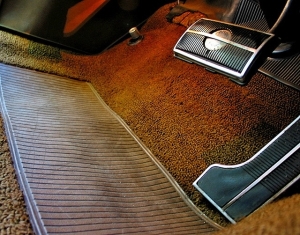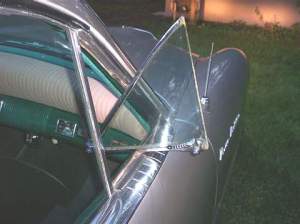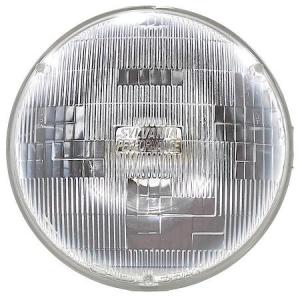10 Automotive Features They Should Have Never Stopped Making
In today’s era of automotive technology, the focus has shifted from creating an icon of comfort and freedom to adhering to strict government imposed regulations. For every feature you will find on a brand new car, there is a law behind it. Safety has become paramount, and form follows function. Additionally, technology has been carefully crafted to provide automotive manufacturers with a firm upper hand when it comes to profits from post-sale repairs and maintenance.
Did you lose or break your key fob to your Chrysler minivan? Well guess what? Your only option is to visit the dealership and pay several hundred dollars for a replacement key and having it programmed. Do you get tired of that pesky low-tire warning light coming on every time the outside temperature drops 10 degrees? Well guess what? Federal law requires that light to be present in all cars made after 2006.
Do you ever wish we could roll back the hands of time and do things a little differently? Providing safety and comfort while still allowing motorists to express their freedom of preference when it comes to certain options and features? Well for those of you who think like me, I have compiled a list of some of the greatest automotive technologies that you no longer find on cars built these days. But these aren’t simply antiquated or obsolete features, these are simple down-to-earth things that made the cars of yesterday so great. Things that were on the side of the owner, not that of the cash-hungry dealership service department.
1.) SKINNY STEERING WHEELS
Some time around the early 1990’s, the thin-rimmed steering wheel began to vanish from cars both domestic and foreign. What we got in exchange was a new era of fat, chubby steering wheels that took after the European sports cars like BMW and Porsche. Supposedly, these allowed for better grip and control, but in my experience, the fatter rimmed steering wheels are harder to keep a hold of when making turns, and begin to grow tiresome after long period of time behind the wheel.
I suppose this is a matter of preference, but I never understood why there was not an option for choosing what type of steering wheel will be fitted onto your new vehicle. No matter what you buy off the showroom floor today, there is zero flexibility in choosing what type of wheel you get. This is the thing you touch the most throughout the entire time you own the vehicle, and yet you have no say in the matter. There are all types of hands and all types of conditions that affect comfort in steering. Arthritis, missing fingers, or simple familiarity with the large-circumference wheels of yesterday. It would sure be nice to be able to have choices when it comes to this matter.
2.) MANUAL TRANSMISSION OPTION
Manually-shifted transmissions started the whole game. Shortly thereafter, automobile engineers invented the automatic transmission. The automatic transmission was considered a luxury item, and was not made mainstream until the late 1960’s for passenger cars, and even later for pickup trucks. By the late 1980’s, the column-shifted manual transmission had vanished from production, and nearly every vehicle produced was being offered with an automatic transmission as standard equipment, except for some base model compact cars and trucks.
Today, you can still get a manual transmission on performance cars and special interest vehicles, but your average run of the mill family vehicle, car or truck, will not come with a manual transmission. Not even as optional equipment. Of course, from a comfort standpoint, automatic is great. One less thing you have to do while trying to drive. And given today’s caliber of highly distracted and generally less-aware drivers, the automatic shift seems like the logical choice. However, there are factors that make having a manual transmission preferable to an automatic, and it would be great to still have the ability to make that choice in any car you decide to buy. For one, manual transmissions are much simpler, mechanically speaking, and aside from clutch replacement, the likelihood of having to rebuild a manual gearbox is far lower than the almost guaranteed overhauling of an automatic transmission at the 100,000 mile mark (or sooner).
In addition to that, manual transmissions have some other attributes that make them handy to have. They possess the capability of kickstarting the engine in the event of a battery or starter failure by means of “popping the clutch”, a phrase and skill that will slowly die out with future generations. Manual transmissions are also better for controlling the performance attributes of the vehicle. It gives the driver the ability to choose when they shift up or down, which can add tons of power when needed, and also to slow the vehicle down while saving wear and tear on brake hardware. Because the manual shifting transmission is able to be manipulated based on driving conditions, it is also highly fuel efficient for the driver who knows how to use it properly. Yet, if you decide you want a brand new Silverado farm truck, you won’t be given the choice of one of these timeless gearboxes. You’re getting an automatic, and you’re going to have to deal with an overhaul at some point.
3.) FLOOR MOUNTED DIMMER SWITCHES
Yet another simple, old-world technology that has gone the way of the dinosaur is the floor-mounted dimmer switch button. Until around 1980, you would find these on the floorboards of most passenger cars, and until around 1990 you would also see them on truck models. This pre-dated the current high-beam dimmer switch, which is now placed on the turn signal switch by industry standard. The current design works well, but I never saw the reason for the elimination of the floor switch. With one swift tap from the left foot, motorists could quickly turn their high beams off as a courtesy to oncoming traffic, or turn them back on when entering poorly lit roads in the dark. It was just one simple task for the left foot, which today sits completely unused throughout the duration of the drive.
4.) PLAIN IGNITION & DOOR KEYS
Who remembers these? You typically got two keys for a vehicle back in the old days. One for the ignition and one for the door locks or trunk. The keys were made of solid brass or other metals, and could easily be duplicated at your local hardware store for a buck or two. Want an extra set of keys for your son or daughter? No problem. These were simple keys to a lock cylinder that could be easily and cheaply serviced or replaced. Today, this is no longer an option.
No matter what you drive, you will be getting a huge plastic key fob with all sorts of buttons on it, and it will be very expensive to replace if you lose it, break it, or submerge it in water. You can’t simply go to the hardware store and make infinite copies, and each one must be programmed by the dealership or a certified locksmith in order to be used. Is the technology great? Absolutely! It is a great theft deterrent, and also makes a very convenient entry as you can simply push a button to unlock the door without having to actually put the key in the lock cylinder and turn it (with your hands full). But this new way of making keys puts an incredible burden of responsibility on the owner, and yet he/she has no power to choose to accept this responsibility. If you want to keep things simple and have a plain jane brass key for your car, you are out of luck, my friend. You just better hope to God you never lose or break that new key fob!
5.) FRESH AIR VENTS
A lot of younger folks don’t even know about this extinct technology. In the days before air conditioning became standard equipment, automotive engineers tried all sorts of ways to improve air flow through the cabin of a hot car interior. One of these ways was a fresh-air ventilation system, a manually operated set of vent doors in the kick panels that could be opened to allow outside air to pass through the cabin, which was a great substitute for having no climate control.
The fresh air systems were typically cable operated slider-controls on either side of the steering column. One for the left side, and one for the right. They could be opened all the way, or just a little, depending on the desire of the driver and passengers. Although it was not pre-cooled air, it was very effective at keeping the cabin air flowing, and in the springtime, it was almost as good as having a/c. For some reason, this technology vanished from the industry shortly after the 1960’s, and cars became increasingly dependent on a functional air conditioner to provide comfort for passengers. In today’s cars, there is little to no relief from the summer heat when your air conditioner goes out, and having one of these fresh air systems would make a world of difference for a lot of people.
6.) VENT WINDOWS
Also referred to as “cigarette windows” by some, these handy triangular windows would be found on most cars and trucks as recently as the 1980’s. Today, this feature is basically non-existent. Back in the days when nearly everybody smoked cigarettes, in their cars, in their homes, and everywhere in between, this was a convenient way of driving with a lit cigarette. It also doubled as a great fresh air feature, as the window vane could be positioned at various angles, directing air into the cabin towards the driver, or towards the dashboard where lots of greenhouse heat would build up. For those who smoked, it was a great way to dispose of ashes without using the car’s ashtray. Rolling the door glass down was not only annoying to passengers in the back seat, but it also sent ashes and dust flying throughout the cabin.
Using these vent windows in conjunction with fresh floor-air systems provided enough adequate airflow to make driving without air conditioning less taxing, but you will not find this handy little feature on any of today’s cars or trucks.
7.) HARDTOP SEDANS
Of all the various body styles that have come and gone over the decades, one of the coolest was undoubtedly the hardtop sedan. This was defined as a car that did not have a pillar or post between the front and rear door, and gave the impression of being a coupe, as the picture above illustrates. The typical passenger car consists of three posts or pillars, the A, B, and C pillar. The B-pillar was not present on hardtops, giving a much more open look to the interior, and cleverly disguising the fact that it was a family car, and not a sportsman’s cruiser.
Hardtop sedans are also devoid of window frames on the side glass, something you typically would only see on sports cars and convertibles. The absence of door glass frames is still seen on some cars today, such as the Subaru Outback, and various German makes, but the open-air hardtop sedan is one work of automotive art that has vanished from showroom floors in the United States.
8.) 1157 BULBS
For those of you who are not mechanically inclined and have no idea how to replace a tail light or turn signal bulb, this one might mean jack squat to you, but for the car person, I think a lot of us miss the general long-term reliability of the brass-bodied 1156 and 1157 bulbs. These were eliminated from mainstream production in most cars by the 1990’s, and replaced by a cheaper, plastic bodied bulb known as the 3157, or variants thereof. The 3157 bulb is just as universal as the 1157, but for some reason they just don’t have the lifespan of the old 1157’s. You may notice today when sitting at a red light that a lot of the vehicles around you have burnt out brake lights. In some cases, the whole set doesn’t work. This is a combination of two factors…decreased lifespan of the bulb, and decreased awareness and accountability of the motorist, who never thinks to check things like that on their own. A lot of people go months or years without checking bulbs, posing a safety hazard for themselves and others. I could go on a rant about how people today just don’t know jack about their own cars, but for now I’m going to stick the blame to this little fellow, the bulb itself. The 1157 bulb was far more superior, and would often last the entire life of the vehicle. In fact, some cars may have gone two or three decades with the same bulb in one socket. Today, you’re likely to have a burnt out turn signal or brake lamp by your first oil change or safety inspection.
9.) SEALED BEAM HALOGENS
In addition to those miniature bulbs, another great automotive technology of the past was the sealed beam halogen headlamp. Cheap, abundant, universal, and easy to install, these were the standard for domestic and foreign vehicles up until the 1980’s, when they were slowly phased out for the European-inspired headlamps that contoured the body of the car.
These sealed beams were either round or rectangular, and operated in sets of two or four. You could buy a replacement at the auto parts store for five dollars, and any average Joe with a Philips screwdriver could change one. Today, headlamp replacement has become an enigma. Some cars aren’t so bad, but a lot of cars have become so complicated that a simple bulb replacement warrants taking the entire front nose panel apart just to insert a new bulb. And those bulbs can be anywhere from $25.00-$500.00, depending on what you drive. A lot of cars today also use LED and Xenon technology for headlamps, and this only adds an extra burden of cost on the motorist, and a nuisance to oncoming traffic. They’ve spent all this time and money figuring out how to light the road better, but hardly any effort has been placed on ease of installation, universal fitting parts, or consideration for the vision of oncoming traffic in the dark. I miss the days when everyone used these. They lit the road well enough, and we could have done just fine using these up to today.
10.) SMALL DIAMETER WHEELS
What the automotive industry has done to the wheel is nothing short of frustrating to me. For decades, the car wheel (or rim) adhered to a very simple standard. 14-15 inches, a simple valve stem, no tire pressure monitoring system, no overly complicated center caps, and you could interchange wheels with all sorts of other cars without having to reprogram the tire monitors, or worry about scratching a delicate designer wheel on the tire machine.
Perhaps the biggest headscratcher for me is how difficult it has become in the last decade or so to find a 14 or 15 inch tires to fit these simple wheels. No matter where you go, if you come in asking for a 15 inch tire, they’re going to look at you like you’re crazy. Without even checking their inventory, they will tell you they don’t have any in stock, and would have to special order them. Really? The road is filled with millions of vehicles that still use these wheel sizes, but because of the trend to larger diameter rims (17″ or higher), we can’t even get a simple tire replacement without placing a special order? It makes me want to punch a brick wall. With my head. Why is it so hard to keep tires like this on hand? And for that matter, why are we as car owners forced to own cars with such large wheels that a tire replacement will cost us upwards of a thousand dollars? To me, that is ridiculous. Maybe I don’t want 20 inch wheels. And maybe, just maybe, I don’t feel like dropping two hundred dollars on a single tire!
Then there is a whole other aspect to consider…the ride itself. It is well known that tires with low profiles (sidewalls) do not offer as smooth of a ride as tires with a lot more sidewall flexibility. The reason all of us reminisce about how old cars used to ride like a cloud is almost entirely based on the type of wheels and tires it used. The 15 inch rim was a perfect idea. It filled up the wheelhouse while still providing enough room for a standard profile tire that would offer a great ride at a great price. I still don’t understand why people spend thousands of dollars upgrading to 24″ rims, only to cut down the comfort and versatility of their brand new vehicle by more than 50%. You see them slow down to a halt before crossing a pothole. Heaven forbid you should put a ding in that $2000 chrome wheel. How practical is that? Paying five figures to drive this handicapped, delicate little flower of a vehicle on the roadway?









